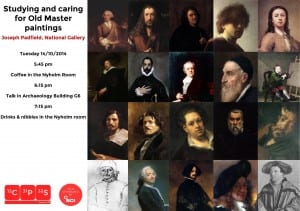Studying and Caring for Old Master Paintings: CPS Talk 14/10/14
By Penny Carmichael, on 24 October 2014
-Article by Stephen Leach
 This week the CPS were joined by Joseph Padfield, a conservation scientist at the National Gallery London. From ancient pigments to modern imaging techniques, the eager CPS audience where about to see through the eyes of a scientist charged with the upkeep of some of the UK’s most treasured paintings.
This week the CPS were joined by Joseph Padfield, a conservation scientist at the National Gallery London. From ancient pigments to modern imaging techniques, the eager CPS audience where about to see through the eyes of a scientist charged with the upkeep of some of the UK’s most treasured paintings.
It began in 1823 when the Government bought 38 paintings for £57,000. In the following years the collection grew and so did the need for its preservation, the first steps taken were to move the entire collection from the Pall Mall to where it currently resides on Trafalgar Square, as Pall Mall was far too grubby for such an illustrious hoard. Air pollution was rather bad in 1800’s London and the first scientific consultation came from Faraday who noted that:
“A person of competent chemical knowledge might be valuably employed”
Now a full team of scientists reside in the gallery. They investigate painting materials and techniques; they are able to chart the weathering of artworks by natural or unnatural forces. They provide new ways of seeing the paintings and document the process of creation. Finally they employ non-invasive methods of preventative conservation.
Materials were treasured for their colours long before anything was known of their chemistry. Lapis Lazuli is a natural zeolite type base for the pigment Ultramarine. It has lent a glorious blue to paintings such as ‘The Girl with the Pearl Ear Ring’ by Vermeer and ‘Bacchus and Ariadne’ by Titian. Colours demonstrate great variety in nature and were among the first qualitative indicators of materials undergoing chemical change.
In some case tiny samples are taken from the surface of paintings in order to investigate exactly which materials where used and in which order. One of these tiny fragments ~ 100 µm provides a cross section of the pigment, the binder and the varnish. From these particles the researchers can discover what techniques were being employed and whether the surface of the painting is still representative of the artist’s original concept. For example, ‘The Portrait of Alexander Mornauer’ by an unknown artist, had undergone an unnatural change. Analysis of the fragment showed a blue colour had been added over a layer of varnish, beneath which was a brown colour. This blue, which made up the background of the portrait, was found to be a Prussian Blue pigment, which was not used until 300 years beyond the established time of creation of this work. It therefore proved that some other individual had painted the brown background blue. The supposed reason for this alteration is that with a blue background it could be passed off for a highly valuable Holbein. It has since been ‘cleaned’ and as a result Alexander Mornauer is represented as intended, with a slightly larger hat.
Light can be a big problem for paintings, but it’s useful when it comes to looking at them. In the 1800’s the paintings were lit solely by daylight, which meant the gallery closed on gloomy days. Now artificial light is employed in concert with natural lighting but great control is exercised over the spectral range and intensity of the light. Some works of Mark Rothko are destined to slumber in dark storage as a result of the extreme light induced fading that the pieces were undergoing. Unfortunately colours may fade over time, the chromophores in organic pigments break down. In ‘The Rokeby Venus’ by Velazquez she now reclines on a sheet of dark grey which was once a rich purple. Painted foliage can appear blue instead of green as the yellow breaks down in the mixture. The fading of vermillion has been linked to trace chlorine quantities, which is why on icy days you’ll not find NaCl scattered on the floor around the National Gallery. The gallery employs LED lighting which has the least possible emission in the UV region and couples this with an automated shutter system on the windows which changes its position minute by minute in accordance to the time of day and year.
Finally we learnt how modern technologies have allowed new insight into how we see paintings. Once X-ray images were producible, it was not long until paintings were irradiated, the first instance being in the 1920’s. This exposed the guts of a painting, for example how canvasses had been patched together, how artists had painted over old works or made subtle changes to detail. For example, in the painting ‘Young Woman Powdering Herself’ by the pointillist Georges Seurat, the artist originally included a self-portrait, which for reasons unknown he decided to cover over with flowers. X-rays reveal that he is still there, peering out from behind the bouquet.
The Gallery also employs an automated image capture procedure which produces exceedingly high resolution images of the works. With such techniques, the 3D contours of the surface can be recorded so that the painting resembles a bas relief, making every brush stroke and indentation traceable. Digital capture of the artworks not only aids study of the pieces but also enables them to be reproduced and shared more widely than ever before. For exhaustive information regarding the science of art conservation at the National Gallery, see below.
http://www.nationalgallery.org.uk/technical-bulletin/
 Close
Close


 Subscribe to this blog!
Subscribe to this blog!